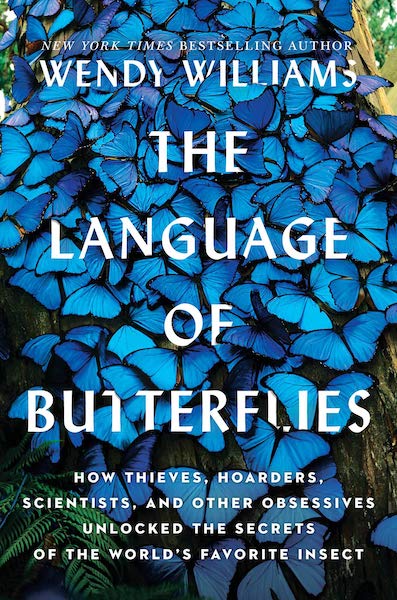 |
by Wendy Williams
Butterflies are one of the world's most beloved insects. From butterfly gardens to zoo exhibitions, they are one of the few insects we've encouraged to infiltrate our lives. Yet, what has drawn us to these creatures in the first place? And what are their lives really like? In this ground breaking book, science journalist Wendy Williams reveals the inner lives of these "flying flowers" - creatures far more intelligent and tougher than we give them credit for.
Monarch butterflies migrate thousands of miles each year from Canada to Mexico. Other species have learned how to fool ants into taking care of them. Butterflies' scales are inspiring researchers to create new life-saving medical technology. Williams takes readers to butterfly habitats across the globe and introduces us to not only various species, but to the scientists who have dedicated their lives to studying them.
Coupled with years of research and knowledge gained from experts in the field, this accessible "butterfly biography" explores the ancient partnership between these special creatures and humans, and why they continue to fascinate us today. Touching, eye-opening, and incredibly profound, The Language of Butterflies reveals the critical role they play in our world.
Science journalist Wendy Williams has lived her life outdoors, either on the back of a horse, on skis, or on her own two feet. She has spent a great deal of time in a variety of countries in Africa, walking in the fields and forests of Europe, and exploring North American mountain chains and prairies. She lives on Cape Cod with her husband and her border collie, Taff. She is author of the New York Times bestseller The Horse.
This is an easy-to-read, inspiring and informative book by an author who is a popular science writer for the New York Times. It is clear from the start that she is a science journalist, rather than a scientist, and the book is organised as a series of stories with a narrative that sometimes reads more like a whodunit than a work of non-fiction. These describe the nature of the relationship between humans and butterflies, the way in which our knowledge of them has developed over the centuries, and the issues that affect them today and will do so in the future.
There are 14 chapters that are grouped together into three main sections entitled Past, Present and Future. I particularly enjoyed the Past section. Amongst other things, it describes the remarkable 34 million year old fossil remains of butterflies found at Florissant, Colorado, in a dried-up ancient lake bed. These include an almost perfectly preserved specimen of a butterfly of the family Nymphalidae, called Prodryas persephone, which bears a more than passing resemblance to our modern-day Red Admiral.
The author also tells the story of the 17th Century German woman, Maria Sibylla Merian, who single-handedly established the science of ecology, despite the twin handicaps of being not very wealthy, and a woman. Incredibly, she was the first person to describe the life-cycle of a butterfly, from egg to caterpillar, chrysalis and adult – something every child learns about today. Prior to Merian's studies, people thought that caterpillars were mere "lowly worms", which were completely different creatures from beautiful flying butterflies. I confess I had never heard of her.
On a more well-known front, Charles Darwin also gets a lot of coverage. The author describes how the discovery of so-called Batesian mimicry in butterflies (in which unrelated species evolve to superficially resemble those that are distasteful to predators) provided Darwin with ammunition to fight detractors of the Theory of Evolution. The latter believed that something as beautiful as a butterfly could not possibly come into existence without the hand of a divine creator.
Much of the second and third sections of the book, Present and Future, are taken up with the story of the Monarch butterfly. This is not entirely unexpected in a book that is written and published in America, but for me too much space is devoted to this one species, magnificent though it is. The author describes visits to the so-called Butterfly Groves of California, where Monarchs in the western USA overwinter. She tells of the disastrous crash in numbers here, due to loss of habitat, climate change and, in recent years, the horrendous wildfires. The Monarchs that live east of the Rockies have not declined as much, but have nevertheless had to cope with enormous changes as a result of human activity. The author describes the wildflower rich, tall-grass prairies, which were grazed by bison and subjected to occasional natural fires that fostered biodiversity. Up to the 19th Century, these covered an enormous tract of land in the Mid-West of the USA, but less than one tenth of one percent of this natural ecosystem now remains. This is habitat loss on a mind-blowing scale.
The author tells a few other stories, such as the successful reintroduction of the Large Blue to England, and similar tales of discovery and extinction (or near extinction) of species of Blues in the USA. However, I would like to have heard more about other American species. At one point, almost as a throwaway, the author describes a visit to a remnant of tall-grass prairie that is home to 200 different butterfly species. Coming from a place where there is less than a third of that number in the entire country, it would have been nice to have learnt a bit more about them.
Overall, I enjoyed reading this book and it was a very pleasant gift to have received at Christmas. However, as someone who has been a butterfly enthusiast for over half a century, I felt that, after a good start, the second and third parts of the book were a bit repetitive and dwelt too much on a single subject. Nevertheless, if it sparks an interest in butterflies in people who have not yet been bitten by the bug, it will have done a good job.